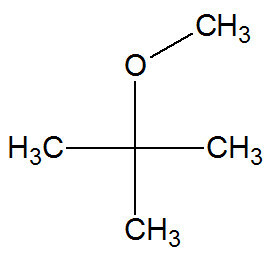To understand what is the gasoline additive, it is important, first of all, to remember what the Gasoline. According to the National Petroleum Agency (ANP), gasoline is a liquid obtained in a fractional distillation process of Petroleum.
When oil is subjected to the fractional distillation process, gasoline is one of the fractions (products) obtained with this method of separation and constitutes a mixture of Hydrocarbons which have in their composition alkanes with four to twelve carbon atoms.

Examples of hydrocarbons present in gasoline
The quality and composition of gasoline obtained in refineries depend on the type of oil that was used in the refining process. The greater the amount of alkanes branched, with more than seven carbons and aromatics, better the quality of gasoline.

Structure of branched alkanes that increase the quality of gasoline
The quality of gasoline is related to the term octane, which refers to the capacity of a fuel to resist, in the engine's compression chamber, without exploding, until there is ignition in the spark plugs.
To be sold at service stations, regular gasoline, obtained at refineries, receives the addition of the so-called anhydrous alcohol (ethanol), which aims to improve the gasoline's octane index.
In the case of gasoline additive, in addition to receiving anhydrous alcohol, this fuel also receives the addition of substances called dispersants and detergents, the which have the function of reducing the formation of deposits in the carburetor, injector nozzles, rods and valves. admission.
In addition to these functions, the detergent substances present in the gasoline additive, still act:
As anti-corrosive materials, preventing clogging and damage to engine parts;
To improve the octane rating;
Minimizing surface ignition, pre-ignition and spark plug failures;
Minimizing the oxidation and formation of viscous gasoline and to improve handling and storage characteristics;
To deactivate traces of copper and other metallic ions that are powerful oxidation catalysts;
Minimizing corrosion and rust in the fuel system;
Preventing the formation of ice in the throttle throttle;
Reducing deposits in the injection system and engine in order to improve explosion.
Among the main substances used as gasoline additives, we can quote:
tetraethyl lead

Structural formula of tetraethyl lead
This organic substance is formed by four ethyl groups and the metal lead. However, when gasoline with this additive is burned, it releases large amounts of this heavy metal into the atmosphere, polluting the air and, consequently, the soil and water.
Due to all the pollution caused by this additive, its use was banned in several countries, however, as its price is very attractive, it is still widely used in the production of gasoline additive.
Tert-butyl-methyl-ether (MTBE)

MTBE structural formula
This is the most used additive currently in place of tetraethyl-lead, as it does not release a heavy metal and does not produces so many toxic gases in its burning process, but also releases less carbon monoxide (CO).
The presence of the oxygen atom in the MTBE molecules makes the combustion process more complete, that is, forming CO2 and not CO. However, it is an extremely soluble substance in water and difficult to be degraded by nature. For this reason, this additive has a great potential to harm the environment when eliminated by automobiles.
By Me. Diogo Lopes Dias
Source: Brazil School - https://brasilescola.uol.com.br/o-que-e/quimica/o-que-e-gasolina-aditivada.htm

